Button training is a highly effective method for enhancing communication between dogs and their humans. By associating specific buttons with different commands or requests, dogs can effectively communicate their needs and desires. However, button training requires a solid understanding of the process and techniques to ensure successful learning.
In this comprehensive guide, we will explore the process of button training for dogs. We will discuss various techniques, the benefits of button training, and provide a step-by-step guide to help you successfully embark on this communication journey with your furry friend.
- Button training involves teaching dogs to use buttons as a means of communication
- Button training offers benefits for both dogs and their owners
- A step-by-step guide is necessary to introduce dogs to buttons, establish associations, and reinforce learning effectively
- Choosing the right buttons and introducing them to your dog is crucial to ensure effective communication
- Consistency and reinforcement are key to solidifying your dog’s understanding of button commands
Understanding Button Training for Dogs
Button training is a technique that involves teaching dogs to use buttons as a means of communication. The buttons are associated with different commands or requests, and by pressing a specific button, dogs can effectively communicate their needs and desires to their owners.
This method of communication has gained popularity in recent years, with many dog owners reporting success in training their dogs to use buttons. The buttons can be customized with words or phrases that are relevant to the dog’s needs and behaviors, making it a versatile training technique.
Button training is based on the concept of “symbolic representation,” which means that dogs can associate a symbol (in this case, a button) with a specific meaning or action. This ability to understand and respond to symbols is a key cognitive skill that dogs possess, and button training helps to enhance their natural communication abilities.
Teaching dogs to use buttons for communication requires patience, consistency, and a good understanding of training techniques. In the following sections, we will explore the benefits of button training, how to get started with button training, and advanced techniques to take your dog’s communication skills to the next level.

There are several techniques for teaching dogs to use buttons for communication. The most common method involves creating associations between specific buttons and commands or requests, using positive reinforcement to reward the desired behaviors.
Other techniques include using physical prompts, such as pointing to the button or physically guiding the dog’s paw, and incorporating verbal cues to reinforce the association between the button and the command.
Teaching Dogs to Use Buttons for Communication
Teaching dogs to use buttons for communication involves introducing the buttons gradually and creating positive associations with them. Dogs may need time to familiarize themselves with the buttons and understand their purpose, so it’s important to be patient and consistent in your training approach.
You can start by introducing a single button and associating it with a specific command or request, such as “outside” or “water.” Once your dog understands the association, you can gradually introduce more buttons and expand their vocabulary.
Using Buttons to Train Dogs
Button training can be used to train dogs in a variety of behaviors, from basic commands like “sit” and “stay” to more complex requests like “play with me” or “I need a walk.” By using buttons as a means of communication, you can enhance your dog’s understanding of commands and their ability to respond to them.
Button training can also help dogs express their needs and desires more effectively, reducing frustration and improving their overall well-being. By understanding your dog’s communication signals, you can build a stronger bond with your furry friend and provide them with a happier, healthier life.
The Benefits of Button Training for Dogs
Button training offers numerous benefits for both dogs and their owners. It gives dogs the ability to communicate their needs and desires effectively, reducing frustration and enhancing their quality of life. Through button training, dogs can develop their cognitive abilities as they learn to associate specific buttons with different commands or requests. Here are some of the key benefits of button training:
- Reduced frustration: Dogs often become frustrated when they are unable to communicate their needs. Button training provides a way for them to express themselves clearly, reducing frustration and promoting a happier, healthier dog.
- Enhanced communication: By using buttons to communicate, dogs and their owners can develop a deeper understanding of each other’s needs and desires. This enhances communication and strengthens the bond between the dog and their owner.
- Improved cognitive abilities: Learning new commands and associations through button training can stimulate a dog’s brain and improve their cognitive abilities.
- Increased independence: Button training allows dogs to actively communicate their needs, promoting a sense of independence and self-sufficiency.
- Reduced anxiety: By having the ability to communicate their needs, dogs may experience less anxiety and stress in certain situations, such as when left alone.
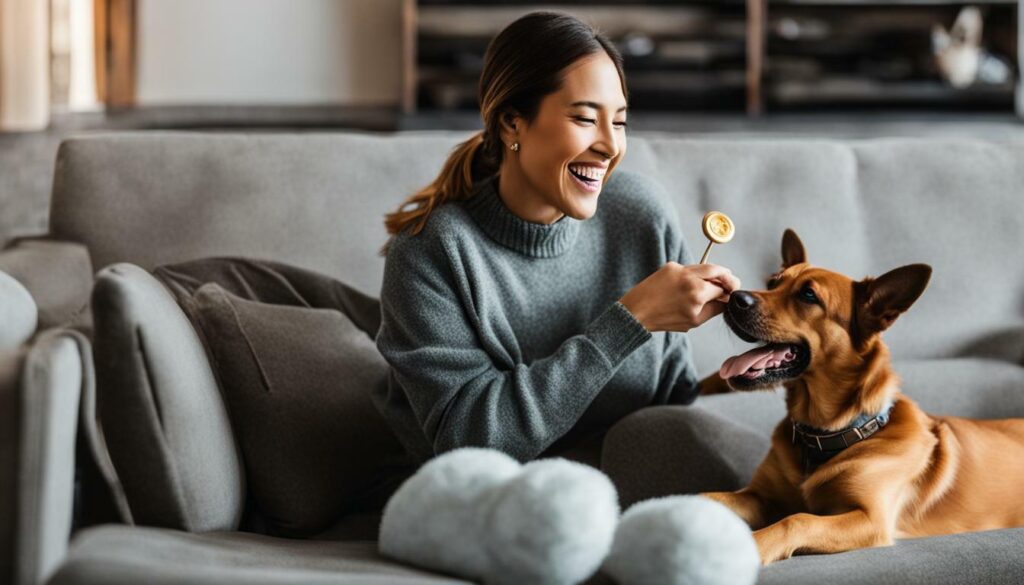
By providing dogs with the skills to communicate more effectively, button training can greatly improve their quality of life and strengthen the bond they have with their owners. In the following sections, we will guide you through the process of button training your dog, providing step-by-step instructions and helpful tips to ensure a successful and enjoyable training experience.
Getting Started with Button Training
Button training involves teaching dogs to use buttons as a means of communication. Before embarking on this training journey, it’s essential to gather the necessary supplies and create a plan. Below is a step-by-step guide on how to introduce buttons, establish associations, and reinforce learning effectively.
Gathering Supplies
The following supplies are necessary for button training:
- Multiple large, durable buttons
- A communication board to place the buttons on (optional)
- Sticky notes or tape to label the buttons
- Treats or rewards for positive reinforcement
Once you have gathered these supplies, you may begin training your dog.
Introducing Buttons
The first step in button training is to introduce your dog to the buttons. Place the buttons in a visible location and encourage your dog to explore them. Use rewards to reinforce positive associations with the buttons. Start with one or two buttons and gradually add more as your dog becomes comfortable.
Establishing Associations and Commands
Once your dog is familiar with the buttons, it’s time to establish associations between specific buttons and commands or requests. Begin by introducing basic commands such as “outside” or “water”. Press the corresponding button when giving the command, and reward your dog when they press the correct button.
Consistency is essential when establishing associations. Use the same commands and rewards every time and avoid confusing your dog with too many commands at once.
Reinforcing Learning and Progress
Reinforcing learning through positive reinforcement is crucial to solidify your dog’s understanding of button commands. Reward your dog each time they press the correct button, and gradually transition to rewarding only when they press the button unprompted.
It’s important to monitor your dog’s progress throughout the training process and adjust your approach as necessary. If your dog is struggling with a particular command, take a step back and reinforce the basics before moving on to more advanced commands.
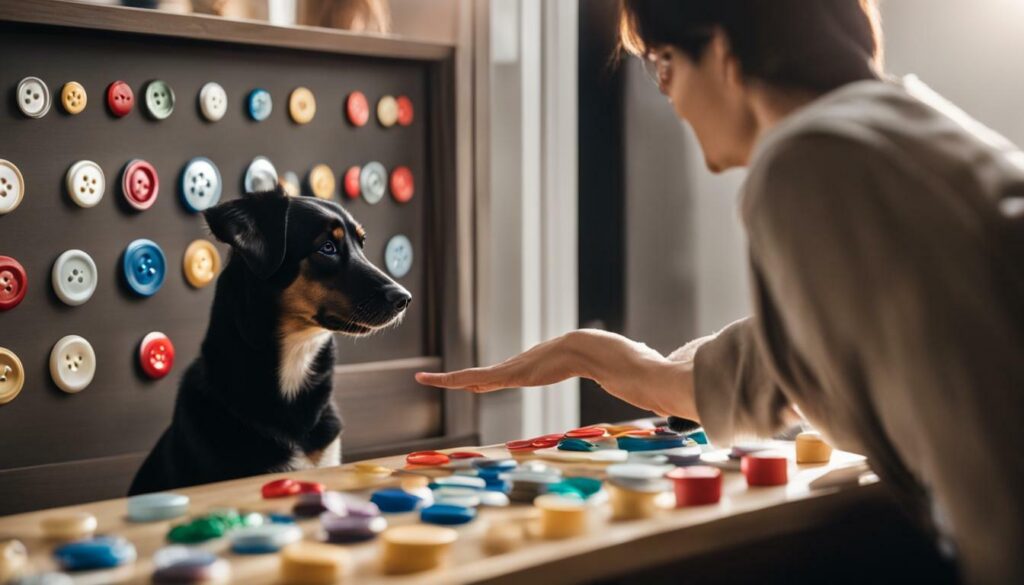
Following these steps will lay the foundation for successful button training. With patience and consistency, your dog will learn to use buttons to communicate their needs and desires effectively.
Choosing the Right Buttons for Your Dog
When it comes to button training for dogs, choosing the right buttons is crucial for successful communication. There are several factors to consider when selecting buttons for your furry friend.
Type of Buttons
There are various types of buttons available, including plastic, metal, and silicone. The type of button you choose may depend on your dog’s size, breed, and level of dexterity. For instance, larger dogs may require larger buttons that are easier to press, while smaller dogs may benefit from smaller, more delicate buttons.
Tip: Consider using buttons with textures or colors that are appealing to your dog to encourage engagement.
Considerations
When choosing buttons for your dog, it’s important to consider the durability and safety of the buttons. Make sure the buttons are made from non-toxic materials and won’t pose a choking hazard if accidentally ingested. Additionally, opt for buttons that are easy to clean and maintain.
Tip: Test the buttons yourself to ensure they are easy to press and won’t break easily.
Introducing Buttons to Your Dog
Once you’ve selected the right buttons for your dog, it’s time to introduce them. Begin by placing the buttons in a location that is easily accessible and visible to your dog. Encourage your dog to investigate the buttons by sniffing and pawing at them, and reward them with positive reinforcement for any interactions with the buttons.
Tip: Consider using a treat or toy as a reward to reinforce positive associations with the buttons.
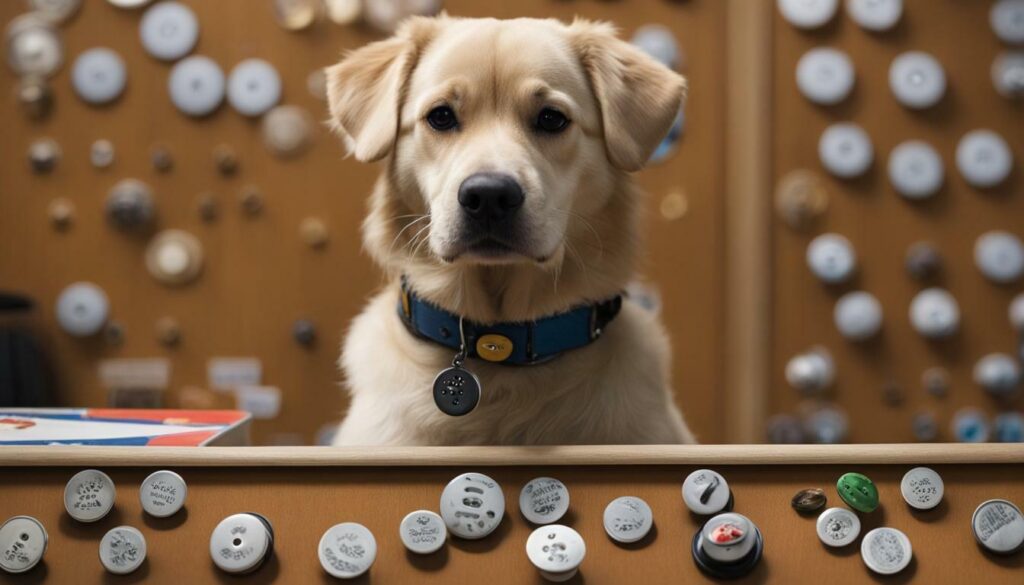
Incorporating buttons into your dog’s training routine requires patience, consistency, and a willingness to adapt to your dog’s learning style. With the right buttons and training techniques, you and your furry friend can enjoy the benefits of effective communication through button training.
Introducing Buttons to Your Dog
Introducing buttons to your dog is the first step towards effective communication through button training. It’s important to make the process engaging and enjoyable for your furry companion to ensure they are motivated to learn.
One effective way to introduce buttons to your dog is through positive reinforcement. Use treats or rewards to encourage your dog to touch the buttons with their paw or nose. You can also try using a clicker to signal to your dog when they have successfully interacted with the button.
Consistency is key in the introduction stage. Try to use the same buttons each time and incorporate them into your dog’s daily routine. For example, place a button by the door and encourage your dog to press it before going for a walk.
Be patient and allow your dog to explore the buttons at their own pace. Some dogs may take longer to become comfortable with the buttons, but with persistence, they will eventually understand their purpose.
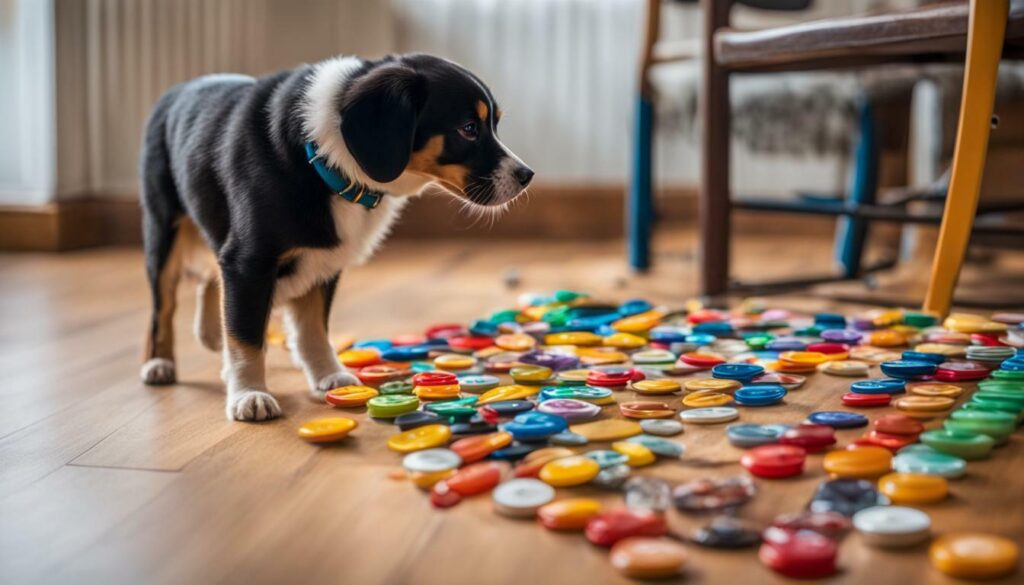
Another technique is modeling. Start by pressing the buttons yourself and then use a command or request associated with the button. Repeat the command while pressing the button to associate the two in your dog’s mind. Eventually, your dog will learn to press the button on their own to signal the desired command or request.
Remember to always keep training sessions short and fun. Overwhelming your dog with too much information or training for extended periods can result in frustration and disinterest.
Establishing Associations and Commands
Now that your dog is familiar with the buttons, it’s time to establish specific associations between certain buttons and commands or requests. This step is crucial to ensure that your furry friend can effectively communicate their needs and desires.
The most effective way to establish associations is through repetition and reinforcement. Start with one or two commands and associated buttons, such as “outside” or “water.” Say the command as you press the corresponding button, then immediately provide a reward or positive reinforcement when your dog responds accordingly.
Be consistent in using the same command and button association every time, as this will help your dog understand and retain the information. Avoid using multiple words or phrases for the same command, as this can lead to confusion and frustration.
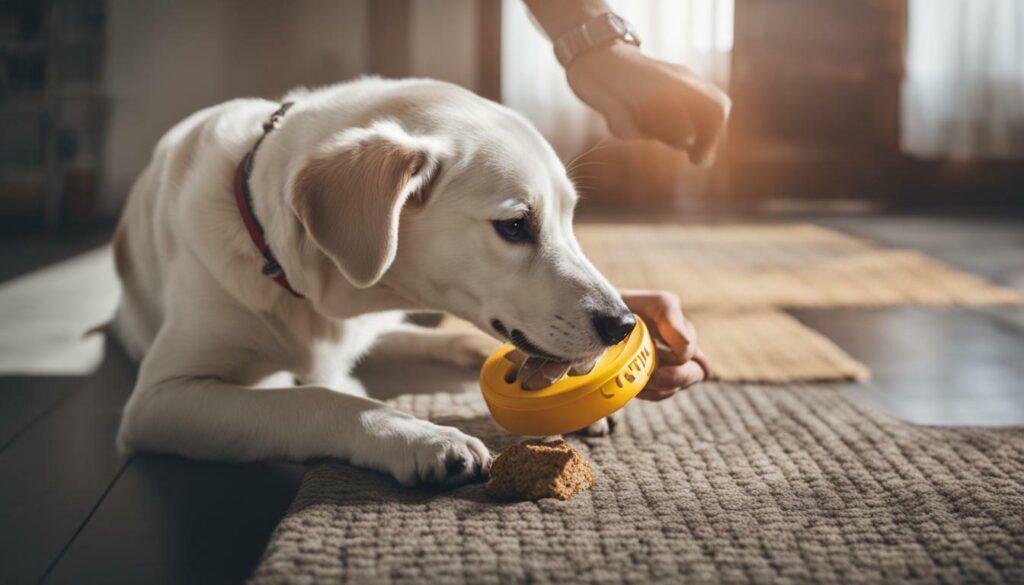
As your dog becomes more proficient in responding to the initial commands, you can gradually introduce new button associations. Just remember to keep reinforcing previously learned commands to ensure continued success.
If your dog is struggling with a particular command, try breaking it down into smaller steps or simplifying the language. Consistency and patience are key to overcoming challenges and achieving success.
In the next section, we will discuss techniques for reinforcing learning and tracking your dog’s progress throughout the training process.
Reinforcing Learning and Progress
Consistency and reinforcement are crucial for successful button training with your dog. Here are some tips to ensure your dog retains the information they learn:
- Repetition: Repetition is key to solidify your dog’s understanding of button commands and establish a communication routine. Practice regularly and reinforce positive behavior.
- Rewards: Positive reinforcement strengthens learning. Reward your dog every time they use a button correctly or follow a command.
- Tracking: Keeping track of your dog’s progress can help identify areas that need improvement. Take note of which buttons your dog is using more frequently and the commands they associate with them.
- Challenges: As your dog progresses, gradually increase the difficulty of the commands or requests. Start small and gradually build up to more complex commands.
Remember that every dog is different and may learn at their own pace. Be patient and consistent, and your dog will soon become a button training pro.
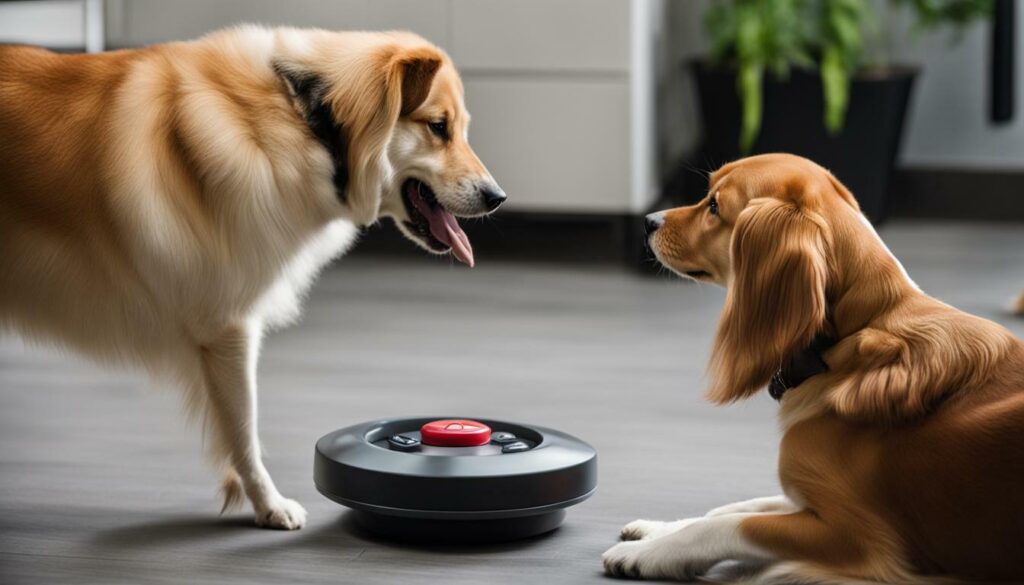
Once your dog has mastered the basics of button training, you can begin to introduce more complex commands and strategies to challenge their communication abilities. The following button training techniques can enhance your dog’s vocabulary and provide more opportunities for them to express themselves:
- Combining buttons: After your dog has learned multiple commands, you can introduce more complex requests by combining two or more buttons. For example, you can create a request for going outside by combining the “go” and “outside” buttons.
- Introducing synonyms: Expand your dog’s vocabulary by introducing synonyms for common commands. For example, you can introduce “potty” as a synonym for “go outside.”
- Teaching associations with different contexts: Dogs are intelligent creatures and can learn to associate different contexts with buttons. For example, you can introduce a specific button for asking to play fetch or go for a walk.
- Introducing sentence structure: Once your dog is comfortable with individual commands, you can introduce sentence structure by teaching them to sequence requests. For example, “go outside” can become “go outside play.”
It’s important to continue reinforcing your dog’s understanding of these commands through repetition and positive reinforcement. As with all button training techniques, consistency is key to success.
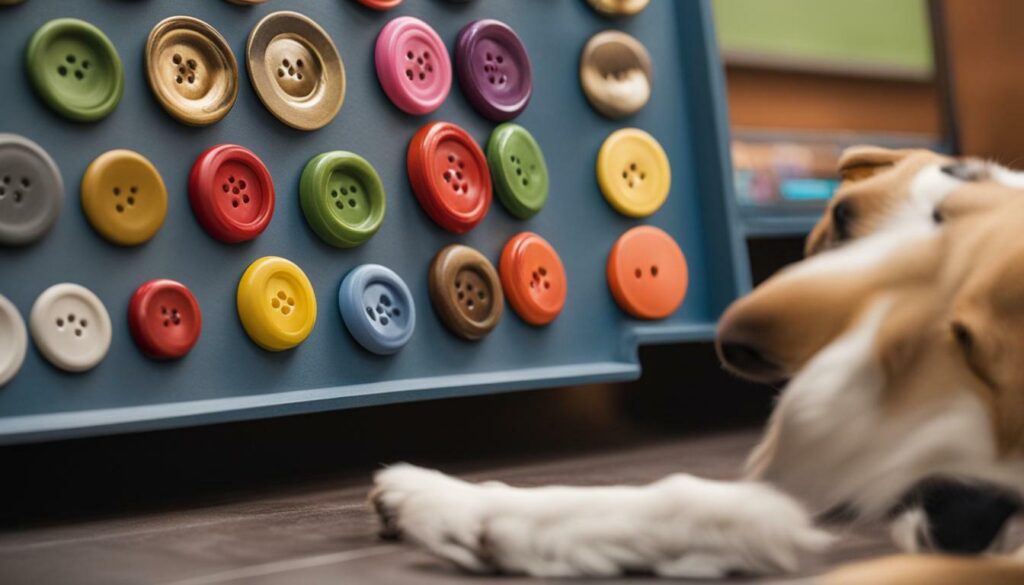
Button training can be a complex process, and it’s important to avoid common mistakes that can hinder your dog’s progress. Here are some tips to help you avoid common mistakes and promote effective button training:
- Not being consistent: Consistency is key in button training. Make sure to use the same commands and associations every time, and ensure that everyone in your household is using the same approach.
- Not reinforcing learning: Reinforcing learning is crucial to help your dog understand and remember the associations between commands and buttons. Use positive reinforcement techniques, such as treats or praise, to encourage your dog and reward progress.
- Introducing too many buttons too quickly: It’s important to introduce buttons gradually, allowing your dog to become comfortable and familiar with each button before introducing new ones. Overwhelming your dog with too many buttons at once can be stressful and confusing.
- Not understanding your dog’s body language: Pay attention to your dog’s body language during the button training process. Signs of stress or confusion may indicate that you’re moving too fast or not effectively communicating with your dog.
- Not addressing challenges: If your dog is struggling with button training, it’s important to address the challenge and adjust your approach as needed. Common challenges include confusion over commands, reluctance to use buttons, or difficulty with certain associations.
- Not practicing regularly: Practice makes perfect, and regular practice is essential for successful button training. Set aside time each day to practice with your dog, and incorporate button training into your daily routines.
By avoiding these common mistakes and incorporating effective button training tips into your approach, you can help your dog succeed and master this unique and valuable communication technique.
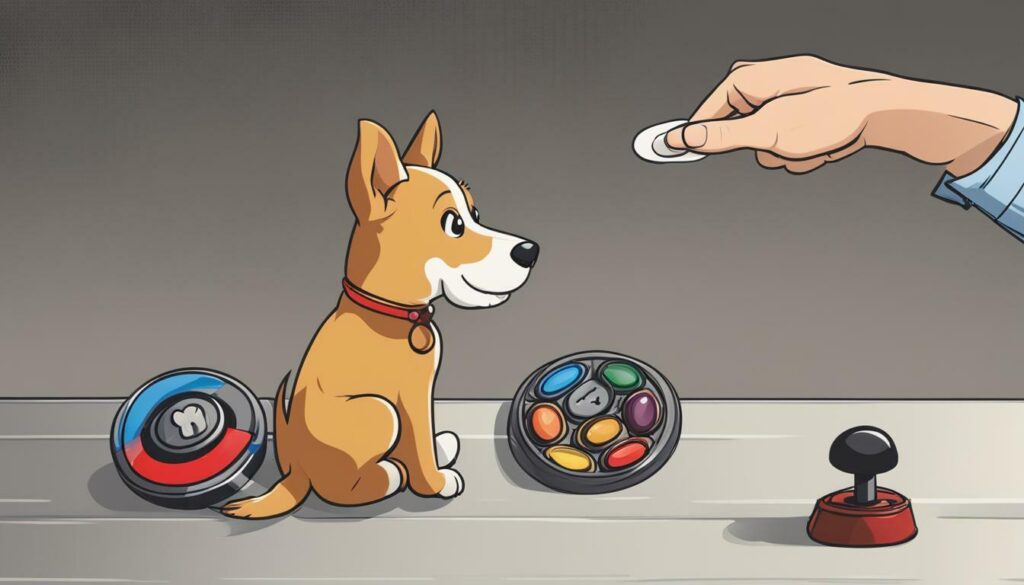
Button training can have a positive impact on your dog’s communication skills and overall behavior. As your dog becomes more familiar with the buttons, it’s essential to incorporate their use into daily life. Here are some tips for using buttons to train your dog successfully:
- Start small: Begin by incorporating buttons into simple, everyday commands such as “walk,” “treat,” or “play.”
- Be consistent: Use the same buttons for specific commands and requests to ensure your dog can make associations easily.
- Encourage your dog to use buttons: Instead of automatically responding to your dog’s requests, prompt them to use the buttons to communicate their needs.
- Practice regularly: Consistent practice is essential in reinforcing learning and ensuring your dog’s continued progress.
- Monitor progress: Keep track of your dog’s progress with button training, and adjust your training plan as needed.
By incorporating button training into daily life, you can strengthen your dog’s communication skills and deepen your bond with them. Remember to remain patient and consistent, and your dog will quickly become a pro at using buttons to communicate effectively.
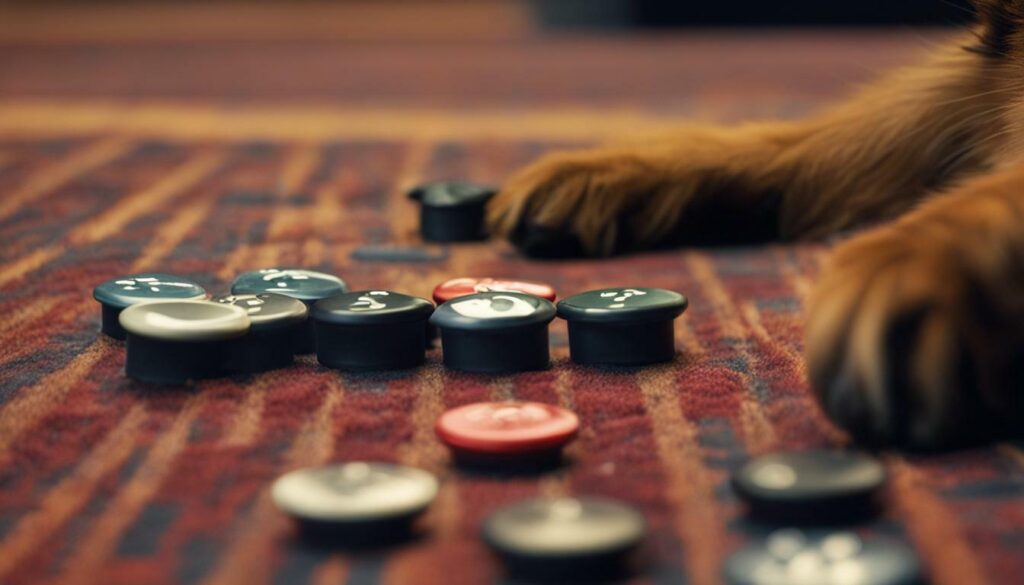
Button training can be a rewarding experience for both you and your furry friend, but it’s not always without its challenges. If you encounter difficulties during the training process, don’t get discouraged. Here are some tips for overcoming common button training challenges:
Problem: Dog isn’t using the buttons consistently
Solution: Consistency is key. Encourage your dog to use the buttons every time they want something, and reward them for doing so. Also, avoid using verbal commands when buttons are available, as it may confuse your dog.
Problem: Dog seems disinterested in the buttons
Solution: Make the training process fun and engaging for your dog. Play games with the buttons, and incorporate them into daily routines. You can also try adding treats or toys to the button area to motivate your dog to use them.
Problem: Dog is pressing multiple buttons at once
Solution: Simplify the button area by removing excess buttons, or placing them further apart. You can also label the buttons with symbols or colors to differentiate them more clearly.
Problem: Dog is confusing button commands
Solution: Ensure that your dog is familiar with each command, and that they are associated with the correct button. Consistency and repetition are key. You can also try using different tones of voice or gestures to reinforce commands.
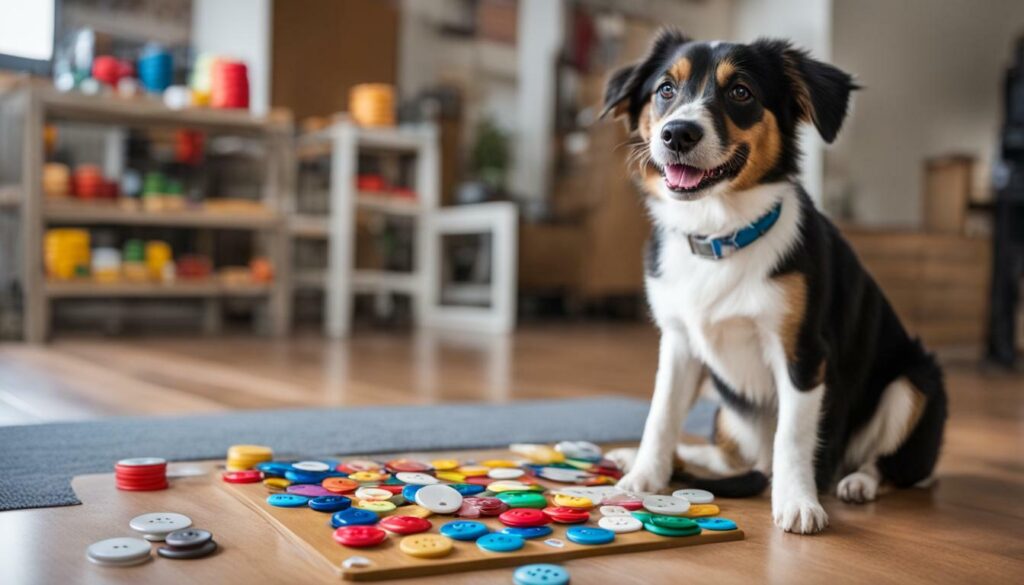
Remember, patience and perseverance are essential to succeed in button training. Don’t hesitate to reach out to a professional dog trainer for additional guidance and support. With time and practice, you and your furry friend can master the art of button training.
Building a Strong Bond through Button Training
Button training is not only an effective way to enhance communication with your dog, but it can also deepen the bond between you and your furry companion. As you work together to develop their communication skills, you will also be building trust and strengthening your relationship.
Consistency in training and positive reinforcement are key to building a strong bond. When your dog uses the buttons correctly, be sure to offer praise, treats, and affection. This will reinforce their understanding of the commands and create a positive association with the training experience.
It’s also important to listen to your dog and respond to their requests. By using the buttons to communicate their needs and desires, your dog will feel heard and understood. This will help build their confidence and trust in you as their caregiver.
Remember to keep training sessions engaging and fun for your dog. Incorporate games, toys, and positive reinforcement to keep them motivated and excited about learning. With patience and consistency, you and your furry friend can master button training and develop an even stronger bond.
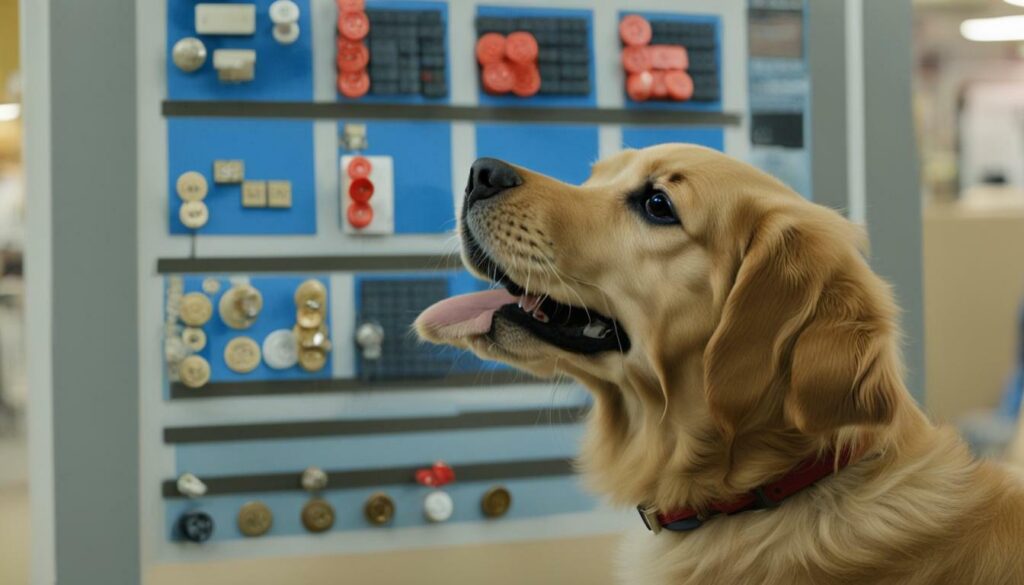
Button training is a process that requires consistency and dedication from both you and your dog. To ensure long-term success, it’s important to keep the following tips in mind:
- Practice regularly: Encourage your dog to use the buttons every day, even if it’s just for simple requests. Consistent practice will reinforce learning and make the process feel more natural for your furry friend.
- Expand your dog’s vocabulary: Once your dog has learned basic commands, consider introducing new buttons to expand their vocabulary and communication skills.
- Be patient: Learning to communicate effectively through buttons is a new experience for your dog. Be patient and celebrate small victories along the way.
- Monitor progress: Keep track of your dog’s progress and adjust your training plan as needed. This will help you troubleshoot any challenges and continue building upon existing skills.
- Use positive reinforcement: Positive reinforcement is key to reinforcing learning and encouraging your dog to continue using the buttons. Remember to praise and reward your dog for their efforts.
By following these tips and incorporating button training into your daily routine, you can master this unique method of communication with your dog and continue building a strong bond for years to come.
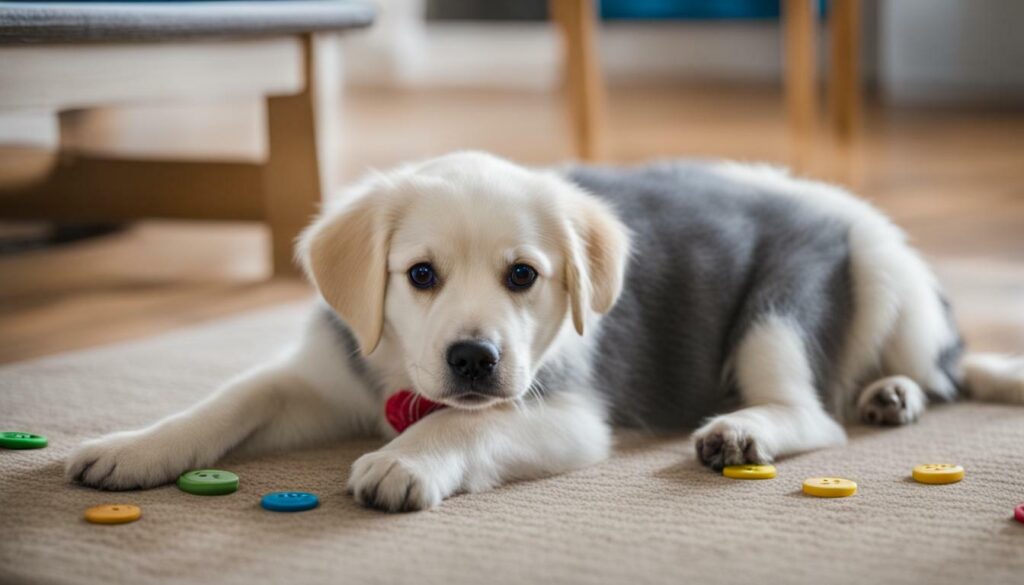
In conclusion, button training is a highly effective way of enhancing communication with your furry friend. By following the step-by-step instructions and tips provided in this guide, you can successfully embark on this journey with your dog.
Remember, consistency and reinforcement are key to successful button training. With ongoing practice and patience, your dog can master this unique method of communication, deepening your bond and enhancing your relationship.
We hope this guide has been informative and helpful in your efforts to master button training for your dog.
FAQ
Q: What is button training for dogs?
A: Button training involves teaching dogs to use buttons as a means of communication. By associating specific buttons with different commands or requests, dogs can effectively express their needs and desires.
Q: What are the benefits of button training for dogs?
A: Button training offers several benefits for dogs and their owners. It provides a way for dogs to express themselves, reduces frustration, enhances communication between dogs and their humans, and can even improve cognitive abilities in dogs.
Q: How do I get started with button training?
A: To begin button training, you will need to gather the necessary supplies and create a training plan. This section will provide a step-by-step guide on how to introduce buttons, establish associations, and reinforce learning effectively.
Q: How do I choose the right buttons for my dog?
A: Selecting the right buttons for your dog is crucial to ensure effective communication. We will discuss the different types of buttons available, considerations for choosing buttons, and tips for introducing them to your dog.
Q: How do I introduce buttons to my dog?
A: This section will outline techniques for introducing buttons to your dog and creating positive associations with them. We will provide tips on how to make the process engaging and enjoyable for your furry companion.
Q: How do I establish associations and commands with the buttons?
A: Once your dog is familiar with the buttons, it’s time to establish associations between specific buttons and commands or requests. We will guide you through the process of teaching your dog to understand and respond to the different button commands.
Q: How do I reinforce learning and track progress?
A: Consistency and reinforcement are key to solidify your dog’s understanding of button commands. We will discuss techniques for reinforcing learning, troubleshooting challenges, and tracking your dog’s progress throughout the training process.
Q: Are there advanced button training techniques?
A: Once your dog has mastered the basics, you can explore advanced button training techniques to expand their vocabulary and communication skills. This section will introduce more complex commands and strategies to challenge your dog’s abilities.
Q: What are common mistakes to avoid in button training?
A: Even with the best intentions, mistakes can happen during the button training process. We will highlight common mistakes to avoid and provide tips to overcome challenges, ensuring a smooth training experience for you and your dog.
Q: How can I incorporate button training into my dog’s daily life?
A: Button training shouldn’t be limited to training sessions alone. This section will discuss practical ways to incorporate button training into your dog’s daily life, fostering continued learning and communication.
Q: What should I do if I encounter challenges during button training?
A: Dogs may encounter challenges or setbacks during button training. We will address common issues and provide troubleshooting tips to help you navigate any obstacles that may arise.
Q: How does button training contribute to building a strong bond with my dog?
A: Button training not only strengthens communication but also deepens the bond between you and your dog. This section will explore the emotional benefits and rewards associated with this unique training method.
Q: How can I ensure long-term success in button training?
A: To ensure long-term success, consistency and ongoing practice are essential. We will provide tips and strategies to maintain and expand your dog’s button training skills over time, allowing for continuous growth and development.
Q: Is there a conclusion to this guide?
A: Congratulations on completing this comprehensive guide on button training for dogs. By following the step-by-step instructions and incorporating the tips provided, you are well on your way to mastering this effective method of communication with your furry companion.
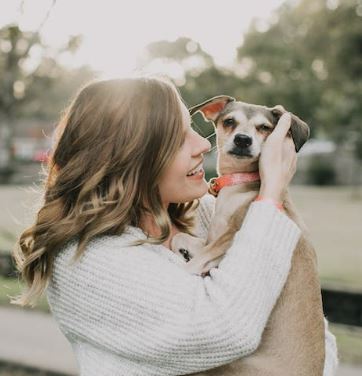
Marissa Delotta, 36, from Dayton, Ohio, is the creative force behind Roverboard.com, a beloved online destination for dog lovers. As a dedicated mom and canine enthusiast, Marissa combines her family experiences with her love for dogs to offer a platform where dog owners can exchange tips, heartwarming stories, and advice. Her website has become a vibrant community for sharing the joys of dog parenting. In her free time, Marissa enjoys exploring dog parks with her family and volunteering at local animal shelters.